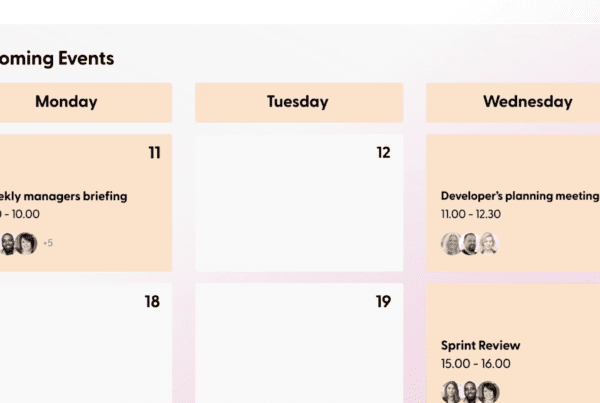Best practices. Sounds simple, right? Self-explanatory.
Something you’ve undeniably heard before. A set of standard guidelines that determine successful outcomes.
What you should be doing to meet high standards, achieve objectives, and reach the loftiest long-term goals
They can be organisational, commercial, governmental, or legal. And more. Tailored to specific businesses and markets.
To use a more familiar commercial term, best practices is benchmarking. They’re insightful. Necessary for decision-making. For continued improvement and growth.
Successful implementation allows organisations to offer a lauded level of service, one that’s championed internationally and admired externally. They are performance enhancers. The most efficient, cost-effective way of doing something. At least in the short term.
But here’s a secret that’s seldom spoken of…Best practices are fluid.
They evolve…All the time.
Think about the software platforms your organisation is currently leveraging. Do they have AI integration? If not, you might not be leveraging best practices. 😟
Let’s have a look at best practices in a little more detail, focusing specifically on sharing best practices.
Continue reading below to discover what your organisation may and may not be doing to optimise performance across all departments.👇
What are sharing best practices?
Introducing best practices is one thing; sharing best practices is another.
Every senior manager or decision-maker knows that an idea is only as good as how efficiently it is put into practice. How much do you buy into? The extent to which the idea can streamline resources.
Imagine for a moment that you’ve had the idea to implement a new CRM.
It delivers a more efficient, streamlined, and less resource-intensive way of managing customer data. Your sales management is honed. Actionable insights are made transparent. Interdepartmental team communication was achieved. Every departmental process, action, and communication was streamlined.
Everyone in the business will be singing from the same hymn sheet. Appreciative of all the work their colleagues do. Everyone will be working together towards a common goal: organisational success. Goals will be set and achieved. The organisation will evolve and grow.
Would you keep these best practices to yourself? 🤔
Recognising best practices is the first step to elevating everyone’s potential performance level so that continuous improvement can be achieved.
It’s not exactly rocket science. However, you’d be surprised at just how often organisations fall into the trap of not identifying, implementing, AND sharing best practices!
The question is: are you happy with the status quo? One that asks your business to do everything the hard way, or do you want to supercharge your organisation?
We know what we’d choose.
What is the sharing best practice model?
People need easy access and clear guidance to efficiently complete everything that requires a little more than an ounce of thought on a day-to-day basis.
This is true of all tasks, from booking and paying for a flight to Johannesburg to assigning, gathering, and reporting workplace responsibilities. Now, best practice may be recommended for all the tasks we complete in our personal lives, but it’s essential in the workplace.
This is where the sharing best practices model comes into play. 🙌
Best practice sharing encourages everyone to define and adopt actions as part of a larger strategy to optimise organisational performance.
An effective model is one that leverages the skills of everyone in the organisation, from HR to sales, operations to payroll, covering everything from people management to bringing new products or services to market, service delivery protocol to marketing.
It’s about giving everyone in the organisation an opportunity to make a difference.
Learning is only half the journey; bringing others along for the ride by promoting organisational transparency and team camaraderie through a unified ideal (a model) is a surefire way to elevate the value of your organisation. 📈
Benefits of sharing best practices
So, it may sound redundant or even obvious, but there are several important benefits to sharing best practices beyond building an environment where everyone feels comfortable in their role, knowing without question what they’re responsible for.
Learning from subject-matter experts ✅
It’s not the top brass who have the sole responsibility for telling everyone, in every department, what they should be doing.
Successful organisations are driven by thought leaders who know their strengths. And their limitations.
They may be experts in building relationships, but when it comes to understanding the ins and outs of how software applications work, well, that’s likely not their area of expertise.
But what if there were cross-departmental subject matter experts spearheading decisions? Having a bunch of subject matter experts means that the organisation has several informal mentors who can help upskill colleagues, boosting their aptitude and confidence.
Achieve that much-valued learning culture ✅
If you think that you’ve heard how important it is to foster a learning culture over and over again, you’re not alone. It’s practically a cliché. But for good reason. It’s paramount to sustained success and, arguably, the single biggest determiner of organisational impact.
The bottom line is that people are encouraged and feel rewarded when they discover new, better ways of doing things. Imagine the satisfaction you could have in knowing that you’ve mastered how to, for instance, leverage AI to optimise your role, get better results, and maybe even save you hours and hours each week.
Having one or two people solely capable of performing essential duties is inefficient. What happens if one or both of them decide to leave? You’ll be stuck! 😟
Sharing best practices and essential resources with other team members, even the whole department, gives your business a backup plan that can create a seamless transition. It will also encourage collaboration and promote teamwork, which has a very clear and undeniable benefit.
Better relationships ✅
Relationships are the cornerstone of success. This is true of all organisations. Encourage people to interact in a meaningful way. Promote workplace and personal relationships, and you’ll be rewarded with team spirit, collaborative depth, and a sense of community.
Identifying and filling knowledge gaps ✅
This one’s important. Especially if you’re intent on upskilling people to bolster cross-departmental performance of everyone of all skill levels across the business.
This helps team leaders, managers, and senior decision-makers optimise performance. Better strategies, processes, and performance measurement will, ultimately, hone productivity across the whole business.
Improving productivity and problem-solving ✅
The better people understand what they’re doing, the more efficient and productive they become.
This is true both theoretically and practically. Remember, knowledge is power, and practice makes perfect! 🤩
By sharing best practices, you can reduce the time everyone takes to complete specific tasks. You can improve efficiency. Stop repeating the same mistakes that often come with trial and error. Save money. And so much more.
Boosts creativity and innovation ✅
Any progressive organisation will place a strong emphasis on creativity and innovation.
After all, to stay relevant, attractive, and even lauded, organisations must encourage everyone in the organisation to share ideas, to not be afraid to try something new, and to, for example, leverage AI to optimise learning processes.
Examples of sharing best practices
So far, we’ve covered what sharing best practices are and their benefits to organisations. But before you consider if this process is suited to your organisation, you really need to see what best practice looks like. This is where the examples of sharing best practices come into play. Below are examples of sharing best practices.
Regular team meetings ✅
Boosting collaboration while reducing unhealthy competition will foster collaboration. Not all workplaces are highly competitive. But some encounter problems if only a select person or two act as informational gatekeepers.
You can solve this problem by holding regular team meetings. Promote an open forum, an environment where everyone has equal footing, and all opinions are equally valid.
Remember, when teams freely share information, advice, and lessons learned, barriers are broken down and a culture of collaboration, not competition, is fostered.
Cross-training ✅
Imagine that you have structured your organisation. You have people with the required skills to perform their roles. But only their roles. And it’s only then that they can perform them.
Now, what happens if someone is off sick? Takes extended annual leave. Decides to leave the business. You’ll find yourself stuck. At best, this will result in operational delays. At worst, you won’t be able to do what needs to be done at all.
A well-rounded, flexible workforce, one with a broad skillset, is essential to seamless operations.
Having someone who can pivot their existing duties to others’ that are more pressing will save you an awful lot of headaches. 👍
Cross-training your teams is essential in today’s fluid commercial environment.
Having, let’s say, a team of marketers who can manage online and offline tasks and content writers who can write content, optimise that content for SEO, and monitor performance is much more efficient than a team who, brilliant though they might be, have limitations on their personal skillsets.
Sharing best practices is essential to cross-training people. Do this, and you’ll build a robust team. One with zero, or very few, knowledge gaps can step up to the plate in someone else’s absence, enhance employee value, and ultimately improve happiness and staff retention.
Peer shadowing ✅
What’s better than learning from the master? Or at least someone who knows their role inside and out?
The benefits of peer shadowing are obvious. Not only does it boost engagement, teamwork, and employee satisfaction, but it also equips employees with their colleagues’ skills, helping them to hone performance and success. ⭐ ⭐
But there’s more. Sharing these best practices creates interdepartmental synergy, and the added knowledge acquired helps employees align goals, exchange ideas, and generally provide more value to an organisation.
After-action reviews ✅
Having an open dialogue, not just during the information-sharing process but once it is over, will help organisations learn, evolve, and adapt. It can also provide organisations with valuable feedback so they can focus any future training on what the organisation needs most.
Best practice workshops ✅
If you want to identify what practices are best suited to your organisation, for whom, and the actions you need to take as an organisation, best practice workshops are the way to go.
From ensuring that the right processes are in place and evolving processes if necessary to defining or cementing existing policies, best practice workshops give organisations a great opportunity to gain valuable insights into people and adjust any workplace policies to meet evolving needs.
Knowledge repositories ✅
To boost knowledge, you need a resource repository. One with a rich volume of information and data, preferably across different mediums: video, audio, the written word, images, etc.
These knowledge repositories are a great way to bolster the learning experience. People learn in different ways. Some people respond to structured lectures; others need to read literature or watch videos to best absorb information. 📚 📚
Building knowledge repositories with a wealth of information in different formats, appropriately categorised, and giving teams access to them will promote continuous learning.
AI peer-to-peer learning platforms that are intuitive and easy to use will help people within organisations thrive by addressing learning shortcomings, providing more opportunities for professional development, and more.
How to document and share best practices
Once you have a knowledge repository, the next stage should be to make sure that all best practices are documented. Having best practices clearly documented and accessible will help get everyone on the same page, heightening collective interdepartmental understanding and relationships.
Be sure to document as much information as you can to help boost understanding of what the best practices are, how to follow them and avoid any pitfalls, and what resources (either digital or people) to use.
Tips for sharing best practices for success across your company
As we all know, it’s all good and well to promote best practice sharing across your organisation and provide access to tools; however, without much encouragement to incentivise people to adopt this ethos, the odds are that best practice sharing won’t take off.
Where does this leave your organisation? Back to square one. 🥹
Below are a couple of tips to help you build effective and organisation-wide best sharing practices.
Create sharing incentives by rewarding people ✅
There are a few ways that you can incentivise practice-sharing adoption. However, one of the easiest and likely most welcome is by offering incentives to people championing best practice sharing.
Now, company shoutouts for a job well done should be a given, but why not offer financial or similar rewards? A few extra quid in people’s pockets never goes amiss! You could also tailor rewards to what people like by distributing vouchers or discount codes for sought-after products and services.
Promote best sharing practices to new starters ✅
Be sure to highlight best sharing practices during the new starter onboarding process. This way, they’ll motivated to hit the ground running and feel part of a team from the moment that they join your organisation.
Once new starters have their feet under the table, they’ll likely create efficient sharing habits of their own and even feel confident enough to provide valuable feedback that could further improve operational efficiency.
Make sure it’s easy to share great ideas ✅
The harder the change is to make, the more effort it takes to implement it, and the less likely people are to want to make it. Cultivate an infrastructure that makes it easy to share great ideas. This way, they’ll be easily adopted.
Assign dedicated time to sharing best practices ✅
A productive workforce is a busy, well-organised workforce. Many people don’t have the time in their week to share best practices. And when they do have a spare half an hour or so, they don’t think about sharing best practices.
Make sharing best practices part of a routine, and people won’t feel like it’s something else that they have to do on top of the never-ending to-do list!
Make sharing best practices a priority in 2024
Many organisations already have one eye on what 2024 will bring. But one thing is true: cultivating an open, collaborative workplace environment where everyone has access to what they need to offer real organisational value and excel in their role is essential to continued success.
This is exactly what sharing best practices can help your organisation achieve. It’s people that drive businesses. People who can offer valuable insights into organisational efficiency and prowess. These insights can help businesses reduce costs, provide a more valued service, and remain competitive into 2024 and beyond.
Whether it’s honing performance by identifying a need for and integrating AI into your L&D, identifying and resolving pain points, or upskilling existing staff so they’re capable of performing a multi-functional role, there’s much that sharing best practices can offer.
Interested in learning how Thirst can help you promote L&D best practices? Book a demo today. 👍
For more e-learning insights, resources and information, discover the Thirst blog.
You may also enjoy:
Learner Engagement: What It Is and Tips to Improve It | What is a Learning Needs Analysis? | What Is Personalised Learning? and How Can It Take Your L&D to the Next Level?






